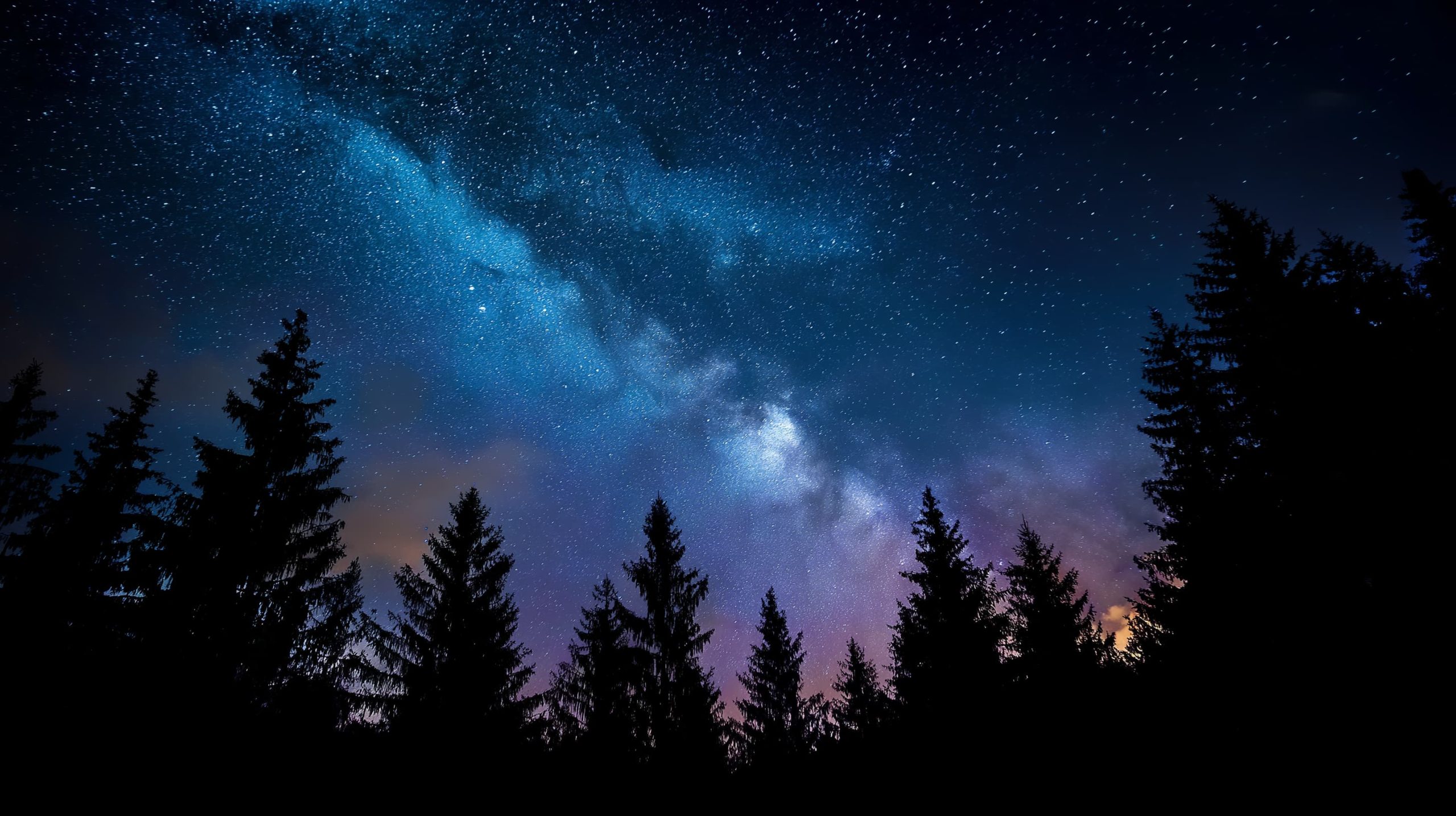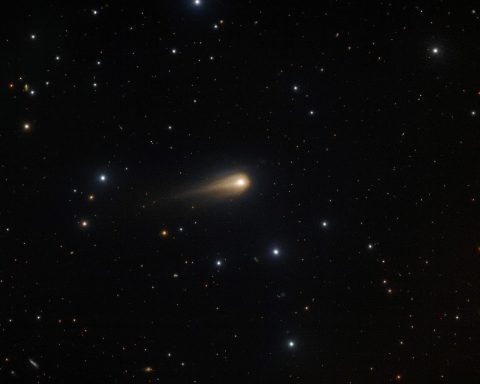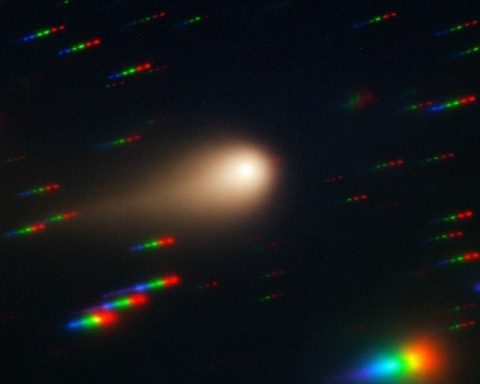- The Perseids meteor shower remains active Aug 18–23, 2025, with peak rates up to 50–100 meteors per hour under dark skies, but a bright Moon 84% full on Aug 12 reduced peak rates to about 10–20 per hour; by Aug 18–19 the Moon wanes to ~23% and ~15% illumination, improving viewing.
- Auroras could appear around Aug 19 due to the solar maximum and a potential minor G1 geomagnetic storm, offering modest displays at high latitudes if solar wind conditions are favorable.
- On Aug 19 (and Aug 20), a slim crescent Moon joins Venus and Jupiter in the predawn eastern sky, forming a striking three-body arrangement with Venus at about magnitude -4 and Jupiter at -2.
- Saturn is near opposition around Aug 26, 2025, with magnitude about +0.4 and the largest apparent size of the year, and on Aug 19 Titan’s shadow transit begins at about 1:26 a.m. EDT, lasting 2.5–3 hours.
- Mars remains visible at about magnitude +1.6 in mid-August, roughly 5–10° above the western horizon 30–60 minutes after sunset as it fades from Virgo.
- Mercury reaches its greatest western elongation on Aug 19, shining around magnitude 0 to +0 and about 5° above the eastern horizon an hour before sunrise.
- Uranus (mag ~5.7) lies in Aries and can be spotted with binoculars in the late night hours, while Neptune (mag ~7.8) is in western Pisces and requires a telescope.
- The International Space Station will have multiple visible passes around Aug 18–19, with about 16 orbits per day (one ~90-minute orbit) and passes lasting 2–5 minutes, trackable via NASA’s Spot the Station.
- NASA Wallops Flight Facility will launch TOMEX+ sounding rockets Aug 18–Sep 3, 2025, with nightly windows 10 p.m.–6 a.m. EDT and using three suborbital rockets: two Terrier-Orion and one Black Brant IX.
- A Long March 5B core stage, about 30 meters long and 20 metric tons, is predicted to re-enter Earth around Aug 18–19 in an uncontrolled event, creating a dramatic sky show if debris survives to the ground.
Get ready for two exciting nights of cosmic delights on August 18–19, 2025. From the lingering streaks of a famous meteor shower to a dazzling dawn trio of planets and Moon, and from possible Northern Lights to rocket launches and satellite flybys, the sky will be buzzing with activity. Below is your comprehensive guide – covering meteor showers, auroras, visible planets, the ISS and satellites, and even human-made space events – so you can plan your stargazing and not miss a thing.
Meteor Showers: Perseids Still Sparkling in Late August
The Perseid meteor shower, one of the year’s most beloved “shooting star” displays, is still active on the nights of Aug 18–19, even though its peak occurred about a week earlier (Aug 12–13). The Perseids officially remain active until August 23 [1] [2], so you may still catch a few meteors each hour on these nights. In a dark sky with no Moon, the Perseids can produce up to 50–100 meteors per hour at peak under ideal conditions [3]. This year the peak was washed out by bright moonlight (the Moon was 84% full on Aug 12) – experts had warned only ~10–20 meteors per hour might be seen during the peak because of the glare [4]. “Instead, you’re probably going to see 10 to 20 per hour or fewer, and that’s because we have a bright Moon in the sky washing out the fainter meteors,” explained Bill Cooke, lead of NASA’s Meteoroid Environment Office [5].
The good news: by Aug 18–19, the Moon has waned to a thin crescent (only ~23% illuminated on Aug 18, and 15% by Aug 19 [6]). This means darker skies and better viewing for any remaining Perseids – you won’t have the same lunar interference as during the peak. You might still see on the order of a few to a dozen meteors per hour late at night, especially after midnight when the Perseid radiant (in Perseus constellation) is higher [7]. To improve your odds, find a safe dark location away from city lights and be patient. The best time is the late-night to pre-dawn hours, when Earth is plowing into the meteor stream head-on [8]. Lie back, let your eyes adapt to the dark (20+ minutes), and scan the sky – Perseid meteors can appear anywhere, though they will all trace back to the northeast part of the sky (near Perseus) if you trace their trails backwards. Even a week after peak, occasional bright fireballs are possible, as Perseid meteors (debris of comet Swift-Tuttle) are known for producing spectacular streaks that sometimes leave lingering trains [9]. Keep in mind the rates will be far lower than at peak, but the Moon’s absence gives you a fighting chance to spot some shooting stars in the comfort of warm August nights.
(Note: The Perseids are best seen from the Northern Hemisphere – they peak on warm August nights up north [10]. Southern Hemisphere observers see far fewer Perseids, since the radiant rises only briefly or not at all for many southern latitudes.)
Auroras and Space Weather: Will the Northern Lights Dance?
With the Sun near the peak of its 11-year activity cycle (the solar maximum of 2025), Earth is experiencing more frequent solar storms – and that means a higher chance for auroras (the Northern and Southern Lights) to put on a show [11] [12]. Auroras occur when eruptions on the Sun (solar flares or coronal mass ejections) blast charged particles toward Earth, sparking geomagnetic storms that light up the upper atmosphere in shimmering curtains of green, red, and purple light [13]. Recently, solar activity has indeed been strong; for example, an extreme geomagnetic storm in May 2024 brought the aurora borealis as far south as California and Arizona – an incredibly rare sight at those latitudes [14].
So what about Aug 18–19, 2025? Space-weather forecasters are monitoring a few features that could influence auroras around these dates. A coronal mass ejection earlier in the month triggered minor geomagnetic unrest around Aug 8–9 (Kp 5–6) [15], and by mid-month the expectation was for quieter conditions [16]. However, a large coronal hole on the Sun was facing Earth in mid-August and sending high-speed solar wind our way [17]. Forecast models indicated a chance of a minor geomagnetic storm (G1, Kp ~5) around Aug 19 as Earth encounters this fast solar wind stream [18] [19]. In fact, long-range aurora outlooks show geomagnetic activity ramping up to “active” levels on Aug 19 [20]. This means high-latitude skywatchers (Canada, Northern US states, Northern Europe, and similarly southerly latitudes in the Southern Hemisphere) could get a modest auroral display if the solar wind conditions are favorable that night. There is no major aurora storm explicitly predicted for Aug 18–19, but forecasts can change on short notice if the Sun erupts again – the solar environment can surprise us! [21] Keep an eye on aurora alerts from NOAA’s Space Weather Prediction Center and sites like SpaceWeatherLive.
If a geomagnetic uptick occurs, the best time to check would be around local midnight or the early hours, when the geomagnetic activity often peaks and your location on Earth is maximally “in the dark” facing the incoming solar wind. Find a dark spot with a clear view of the northern horizon (or southern horizon if you’re in southern Australia/NZ or Antarctica for the Aurora Australis), and watch for any faint greenish glow or pulsating light low in the sky. Even if only a minor storm happens, those at high latitudes could see a modest auroral arc or patches. And remember, with the Sun so active, surprise geomagnetic storms are always possible [22] – we are in an aurora-rich period. “We anticipate additional solar and geomagnetic storms leading to opportunities to spot aurora over the next several months,” says Kelly Korreck, a NASA heliophysics scientist [23]. And as NOAA space weather coordinator Bill Murtagh points out, “The bigger the storm, the more visible the aurora, [and] the further south it’s visible.” [24] In other words, mild solar storms will keep auroras dancing around the polar regions, while really big storms (more likely near solar max) can push the Northern Lights into much lower latitudes [25].
Bottom line: check the aurora forecast on Aug 18–19 – there is a chance (though not a guarantee) that the Northern Lights could make an appearance, especially for northern skywatchers, if the anticipated solar wind stream sparks a G1-class event [26]. And even if the aurora remains elusive, the night sky those evenings will still offer plenty of other wonders to enjoy – from meteors to planets to the glowing Milky Way – so either way, it’s worth spending some time under the stars!
Visible Planets & Dawn Alignment: A Planetary Trio Steals the Show
Five planets are on display in the sky in mid-August 2025, and Aug 18–19 brings particularly beautiful alignments – including a photogenic gathering of the Moon with two dazzling planets at dawn. Here’s what to look for:
- Venus & Jupiter – The Brilliant Pair: The two brightest planets in Earth’s sky, Venus and Jupiter, have been putting on a spectacular show in the pre-dawn hours all month. They had an extremely close conjunction around Aug 11–12 (approaching within ~1°) [27], and by Aug 18–19 they remain a striking duo in the east before sunrise, separated by only a few degrees. Venus blazes super bright (around magnitude –4), and Jupiter, while a bit dimmer (about –2), is still brighter than any star [28]. You can’t miss Venus – it’s the brilliant “Morning Star” about 20–30° above the horizon an hour or two before sunrise [29]. Look nearby for Jupiter, shining with a steady light. The highlight: on the morning of August 19 (and again on Aug 20), a slim crescent Moon joins this planetary pair [30]. In the predawn hours of the 19th, the waning crescent Moon will sit just a few degrees above Jupiter (about 7° apart) [31], forming a lovely triangle with Venus further below. By the next morning Aug 20, the Moon will have moved and will appear just a few degrees from Venus instead [32]. This Moon-Venus-Jupiter trio will be a must-see tableau in the eastern sky before sunrise – a great photo opportunity and a beautiful sight with the naked eye [33]. (Tip: Start looking ~2 hours before sunrise when it’s still dark; as dawn twilight grows, the planets and Moon will be one of the last things visible against the brightening sky.)
- Saturn – Ringed Jewel at Opposition: Saturn, the lord of the rings, is now reaching prime time in the late summer sky. It rises in mid-evening and is visible all night long. In fact, Saturn is just about at opposition (its closest approach to Earth for the year) – it will reach opposition on August 26, so in the days around Aug 18–19 it’s nearly at peak brightness (around magnitude +0.4) and largest apparent size [34]. You’ll find Saturn rising in the east by ~9–10 p.m. local time in mid-August [35], and by midnight it’s high in the southern sky. It resides among the stars of Aquarius (near the Pisces border), appearing as a somewhat golden “star” that doesn’t twinkle. Even a small telescope or good binoculars will reveal Saturn’s famous rings (the rings are currently tilted nearly edge-on from Earth’s view in 2025, but still visible) [36] [37]. Late at night, Saturn is almost due south and will set in the west by dawn. Bonus for telescope owners: On the night of Aug 18–19, Saturn offers a rare treat – its largest moon Titan will cast a tiny black shadow onto Saturn’s cloud tops, in an event called a shadow transit [38]. This transit begins around 1:26 a.m. EDT on Aug 19 (late evening Aug 18 for western time zones) and lasts 2.5–3 hours [39]. Through a decent telescope (~6-inch or larger recommended), skilled observers might spot Titan’s inky shadow slowly crossing Saturn’s disk. Such events are relatively rare and will disappear for many years after 2025 [40], so this is a special (though challenging) observation for enthusiasts with a telescope.
- Mars – Fading Ember in the West: Mars is still hanging on in the evening sky, but just barely. The Red Planet now appears as a dim, reddish star low in the west after sunset [41]. Back in the spring Mars was much brighter, but Earth and Mars have since receded far apart in their orbits – by mid-August, Mars has dwindled to about magnitude +1.6, only ~60% as bright as it was in May [42]. About 30–60 minutes after sunset, try spotting Mars about 5–10° above the western horizon (roughly the width of your fist at arm’s length). It will be one of the only star-like points in the fading twilight, with a subtle orange hue. Don’t wait too long – Mars sets roughly an hour or two after the Sun, so by late evening it’s gone. While not particularly impressive now, it’s still neat to catch Mars as it makes its final appearance in Virgo’s stars. (Mars is gradually heading toward the far side of the Sun from our viewpoint; it will return to prominence in late 2025 when it emerges in the morning sky.)
- Mercury – Quick Twilight Challenge: Mercury, the innermost planet, makes a brief cameo in mid-August. In fact, August 19 marks Mercury’s greatest western elongation – meaning it’s at its maximum apparent separation from the Sun in the morning sky [43]. Around this date, keen-eyed observers might catch Mercury low in the east just before sunrise. On Aug 18–19, Mercury will be shining at about magnitude 0 to +0. – That’s reasonably bright – but the difficulty is its low angle: only about 5° above the horizon an hour before sunrise (for mid-northern latitudes) [44]. To spot it, you’ll need a very flat, unobstructed eastern horizon (ocean or prairie view) and clear skies. About 30–45 minutes before sunrise, look in the brightening dawn glow for a tiny, starlike point down to the lower left of where Venus and Jupiter are located. Binoculars can help pick Mercury out of the twilight. If you succeed, congratulations – Mercury is notoriously tricky to observe! (By later in August, Mercury will actually switch over to the evening sky for observers in the Southern Hemisphere. But for now, in mid-month, it’s a morning object for the Northern Hemisphere. And on Aug 21, the waning crescent Moon will sit nearby Mercury – about 5° away – which could help as a pointer, though by then Mercury will be a tad dimmer [45].)
- Uranus & Neptune – Faint Distant Worlds: While not visible to the naked eye, the two outermost planets can be spotted with binoculars or a telescope under dark skies. Uranus (magnitude ~5.7) is lurking in the constellation Aries, which rises in the late night hours. By the pre-dawn, Uranus is fairly high in the east-southeast. If you have binoculars, you might find Uranus as a tiny, pale greenish star among the background stars of Aries (star charts or astronomy apps can help zero in on it). Neptune (mag ~7.8) is dimmer and requires a telescope; it’s currently in western Pisces, not far from Saturn in the sky [46]. In fact, Saturn and Neptune are “neighbors” in Aquarius/Pisces right now (only a few degrees apart on the sky), but Neptune’s faintness means you’ll need optical aid to see it. For those with telescopes, Uranus will show a small green-blue disk, and Neptune an even tinier bluish dot. Though challenging, observing these distant worlds can be rewarding knowing you’re glimpsing planets billions of kilometers away.
Summary: Throughout Aug 18–19 nights, at least one planet is visible at any given time. Just after sunset you’ll catch Mars low in the west. By late evening Saturn is rising and will dominate the overnight hours. And in the pre-dawn, the Venus-Jupiter-Moon grouping will grab your attention in the east. It’s a true planetary parade – so be sure to look up and enjoy the wandering stars gracing our skies.
ISS Flyovers & Satellites: The Space Station Glides By
While you’re out under the night sky, also keep an eye out for human-made “stars” silently cruising overhead. Chief among them is the International Space Station (ISS) – the largest human-made object in space – which often makes bright flybys at dawn or dusk. The ISS orbits Earth about 16 times per day (one orbit every ~90 minutes) [47]. When conditions are right, it appears as a bright, steady-moving light sliding across the sky, usually taking 2–5 minutes to go from one horizon to the other. Unlike planes, it has no flashing lights and doesn’t change direction – it simply glides at a fast clip (it’s actually traveling ~28,000 km/h, which is why it crosses the sky in just a few minutes) [48].
On Aug 18–19, the ISS will indeed have multiple visible passes for many locations around the world (visibility always depends on your latitude and the station’s orbit). All sightings occur within an hour or two of sunrise or sunset – that’s the sweet spot when the ground is dark but the ISS is high enough to be catching sunlight [49]. For example, in mid-August the ISS has been making predawn passes over Europe and North America: skywatchers in Warsaw saw a bright pass around ~4:30 AM local time on Aug 15, and New York had a pass just before 5:00 AM [50]. Similar early-morning flyovers are expected to continue on the 18th and 19th for those and other mid-northern locales. (At other latitudes and other dates, the ISS might be visible in the evening instead – it varies.) To know exactly when and where to look for the ISS in your location, it’s best to use a tracker: NASA’s Spot the Station service or the popular Heavens-Above website will give you precise flyover times, directions, and elevations [51]. Typically, the ISS will appear as a bright star rising in the west or northwest, then arcing across the sky and disappearing in the east or southeast (or sometimes it slips into Earth’s shadow and “winks out” while overhead). If you do spot it, it’s unmistakable – often rivaling Venus in brightness and captivating to watch knowing there are astronauts aboard that fast-moving light [52].
Aside from the ISS, you might also catch other satellites gliding by. For instance, China’s Tiangong space station occasionally shines with a similar (though slightly dimmer) steady glow as it passes over, and can be spotted if you know when to look. Additionally, SpaceX’s Starlink satellites sometimes create a noticeable train of lights: when a fresh batch of Starlink minisats is launched, they initially stick together in a line, appearing as a string of faint stars moving in unison. In early August 2025, SpaceX launched another batch of Starlink satellites, so it’s possible around Aug 18–19 you might see a “satellite train” – essentially a series of dim dots following one another across the sky [53]. These are usually best seen in very dark skies (they aren’t nearly as bright as the ISS), and they disperse over time, so the effect is strongest within days of the launch. If you catch it just right, though, it can be an eerie but fascinating sight. (Many people have reported seeing such Starlink trains and mistaking them for a fleet of UFOs!)
Do note that there are countless satellites up there – most are too faint to notice, but on any clear night you’re likely to see a few random satellite glints if you observe for a couple of hours. One fun phenomenon is iridium flares (caused by reflections off certain satellites’ flat panels), but those are less common now after satellite retirements. Still, keep watch and you might catch a quick flash or glint from a tumbling satellite or spent rocket body.
The star of the show, however, remains the ISS. If you’ve never seen the Space Station, make it a part of your Aug 18–19 viewing plan – it’s a tangible reminder of humanity’s presence in orbit. As you watch that bright point sail by, give a wave to the astronauts on board!
Rocket Launches & Reentries: Human Activity Lights Up the Sky
Spacefaring nations and companies aren’t taking a break – several rocket launches and events coincide with these dates, adding to the skywatching excitement (even if some are only visible indirectly):
- NASA Rocket Launch from Virginia: Starting on August 18, NASA’s Wallops Flight Facility in Virginia is conducting a series of sounding rocket launches for a science experiment. The mission, called TOMEX+ (Turbulent Oxygen Mixing Experiment Plus), will use three suborbital rockets (two Terrier-Orion and one Black Brant IX) to study upper-atmosphere phenomena [54]. The launch window runs nightly from Aug. 18 through Sep. 3, 10 p.m. to 6 a.m. EDT [55]. That means on the nights of Aug 18–19 and 19–20, there is a chance one or more rockets will blast off in the late-night or early-morning hours (the exact timing depends on conditions and schedule). These sounding rockets are relatively small, but if you live in the U.S. Mid-Atlantic region (e.g. Virginia, Maryland, Delaware, etc.), you might catch a brief glow or streak near the horizon when they launch. Past Wallops launches have been visible as a moving point of light or a fast streak to observers from several states away, especially if launch occurs on a clear night. NASA usually provides live updates on their Wallops Facebook and X (Twitter) feeds [56]. So if you’re nearby, it could be worth stepping out and glancing toward Wallops at launch time – you might witness a rocket piercing the sky (for a few seconds you’ll see the rocket’s bright exhaust flame). It’s a localized event, but an exciting one for those in viewing range.
- Spectacular Un-Launch: Rocket Reentry Fireball: Intriguingly, a large spacecraft reentry is expected around Aug 18–19. On August 13, China launched a Long March 5B rocket carrying a set of satellites, and the massive core stage of that rocket (about 30 meters long, 20 metric tons) was left in low Earth orbit [57]. Now, that spent core is coming back down uncontrolled – and predictions indicate it will tumble back to Earth roughly around Aug 18 or 19 (give or take a day) [58]. Uncontrolled reentries are notoriously hard to time precisely – even a few hours error can shift the debris fall zone by thousands of kilometers [59]. The U.S. Space Force and other tracking agencies will issue forecasts a day or two prior, but the exact time/location will only be known within a few hours of reentry [60]. Why does this matter for skywatchers? If reentry happens over a populated region at night, observers could witness a spectacular sight – essentially a huge man-made fireball streaking across the sky as the rocket stage breaks apart and incinerates [61]. Most of the rocket will burn up from atmospheric friction, but some pieces (especially dense parts like engines) could survive to reach the ground or ocean [62]. Astronomer Jonathan McDowell notes this Long March 5B core is “the most massive object to make an uncontrolled re-entry in decades” [63] (since the 1991 Salyut-7 space station), drawing criticism of the practice of letting such a big object fall unguided [64]. The odds of debris hitting anything or anyone are extremely low (Earth is mostly ocean, and even land has lots of empty space) [65]. But if you happen to be under its path at the right time, you could see a breathtaking show – video footage from past such reentries show a train of bright fragments arching overhead, like a slow-motion meteor outbreak. For most of us, this event will likely go unnoticed (it will probably reenter over an ocean or uninhabited area, as is most often the case [66]). Yet it’s something to be aware of – and a reminder that our sky is becoming busier with human objects. (If you’re curious, keep an eye on updates from U.S. Space Command or satellite trackers on social media for news of when/where this reentry happens.)
- SpaceX & Other Launches: Around these dates, SpaceX is busy as usual. In fact, on August 17 (U.S. time) SpaceX launched another Falcon 9 mission (Starlink Group 17-5) from California, deploying 24 more Starlink internet satellites [67]. That launch occurred late morning local time, so it wasn’t visible as a night-sky spectacle; however, the newly launched Starlink satellites are the ones contributing to those “trains” we mentioned in the satellite section. Looking a couple of days beyond our target dates: Roscosmos (Russia) plans to launch a Soyuz 2.1a rocket on Aug 20 from Baikonur Cosmodrome, carrying the Bion-M No.2 satellite – a space biology research mission with animal and plant experiments on board [68]. And on Aug 21, SpaceX has another high-profile launch: a Falcon 9 is scheduled to lift the USSF-36 (OTV-8) mission [69]. This mission will carry the U.S. Space Force’s X-37B spaceplane (an uncrewed reusable mini-shuttle) on a secretive orbital test flight [70]. While these launches won’t be directly visible to most skywatchers (they occur at specific launch sites and times), they highlight the flurry of space activity surrounding mid-August. And if you do live near a launch site (e.g. coastal California, Florida’s Space Coast, or Baikonur in Kazakhstan), a rocket launch can be an unforgettable sight – a blazing rocket plume and, in some cases, a twilight “jellyfish” glow if a launch happens near sunrise or sunset. No major civilian launch is happening exactly on the nights of 18th or 19th, but the cumulative effects of these activities (like the Starlink satellites and the rocket reentry) tie into the sky shows you might catch.
In summary, Aug 18–19, 2025 is brimming with celestial and technological sights. From nature’s own fireworks (Perseid meteors) to the ethereal aurora, from a gathering of brilliant planets and a delicate lunar crescent at dawn, to the stark glow of the ISS and the flare of rockets and reentering space junk – our sky will showcase the dynamic interplay of cosmic phenomena and human ventures. It’s a wonderful time to look up, be it for a relaxing bit of stargazing or an exciting hunt for specific events. Clear skies, and happy skywatching – these nights have a little something for everyone! [71] [72]
Sources: NASA, NOAA Space Weather Prediction Center, American Meteor Society, EarthSky, Space.com, Astronomy Magazine, TS2 Space news [73] [74] [75] [76], and other expert references as cited above. Enjoy the show!
References
1. www.amsmeteors.org, 2. www.amsmeteors.org, 3. ts2.tech, 4. ts2.tech, 5. ts2.tech, 6. www.moongiant.com, 7. ts2.tech, 8. ts2.tech, 9. ts2.tech, 10. www.amsmeteors.org, 11. ts2.tech, 12. ts2.tech, 13. ts2.tech, 14. ts2.tech, 15. ts2.tech, 16. ts2.tech, 17. earthsky.org, 18. www.auroraadmin.com, 19. www.auroraadmin.com, 20. www.auroraadmin.com, 21. ts2.tech, 22. ts2.tech, 23. ts2.tech, 24. ts2.tech, 25. ts2.tech, 26. www.auroraadmin.com, 27. science.nasa.gov, 28. ts2.tech, 29. science.nasa.gov, 30. science.nasa.gov, 31. www.astronomy.com, 32. www.astronomy.com, 33. science.nasa.gov, 34. ts2.tech, 35. ts2.tech, 36. ts2.tech, 37. ts2.tech, 38. ts2.tech, 39. ts2.tech, 40. ts2.tech, 41. ts2.tech, 42. ts2.tech, 43. www.astronomy.com, 44. www.astronomy.com, 45. www.astronomy.com, 46. ts2.tech, 47. ts2.tech, 48. ts2.tech, 49. ts2.tech, 50. ts2.tech, 51. ts2.tech, 52. ts2.tech, 53. ts2.tech, 54. www.nasa.gov, 55. www.nasa.gov, 56. www.nasa.gov, 57. ts2.tech, 58. ts2.tech, 59. ts2.tech, 60. ts2.tech, 61. ts2.tech, 62. ts2.tech, 63. ts2.tech, 64. ts2.tech, 65. ts2.tech, 66. ts2.tech, 67. www.space.com, 68. www.space.com, 69. www.space.com, 70. www.space.com, 71. ts2.tech, 72. ts2.tech, 73. science.nasa.gov, 74. ts2.tech, 75. www.amsmeteors.org, 76. ts2.tech










